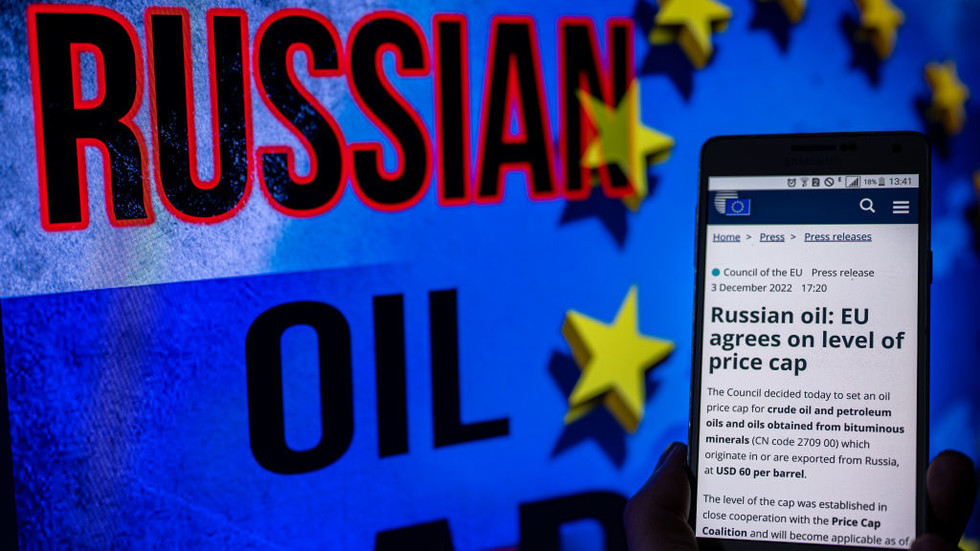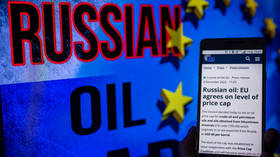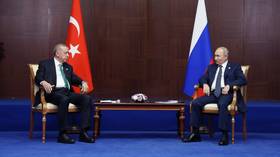
After months of back and forth, the scheme finally begins as questions remain about how it will work in practice
By Ivan Timofeev, Valdai Club Programme Director & one of Russia’s leading foreign policy experts.

EU logo with Russian flag on screen with EU Commission press release on mobile. EU Russian oil Price cap, EU agrees $60 price cap on Russian oil. In Brussels, Belgium on 4 December 2022. © Photo Illustration by Jonathan Raa/NurPhoto via Getty Images
Monday is D-Day for the West’s attempt to place a price cap on Russian oil exports. In building up pressure on Moscow, the US and its allies will use their considerable experience of restrictions against Iran. Tehran continues to survive under the sanctions, although it has suffered losses. There is no doubt that Russia will also retain efficient ways to supply its oil to foreign markets. However, as in the case of Iran, the sanctions will increase the cost of those exports.
A price threshold for Russian oil had been discussed for several months. The idea was announced back in early September in a statement by the G7 finance ministers. Its essence was to prohibit the transportation of Russian oil and oil products by sea when the contract price exceeds a predetermined price level. Along with transportation, there are related services, such as insurance, financing, and brokerage services. A ‘price threshold coalition’ was formed, which, along with the members of the G7, included Australia and the EU member states.
Washington, London, and Brussels have already developed legal mechanisms for the new restrictions. On Monday, they come into force, and, in February, they are expected to be applied to oil products. The initiators of the sanctions expect attempts to circumvent them and have been trying to close possible loopholes in advance. What kind of workarounds do Western countries expect, and what are the chances they’ll be able to impose a price cap on other states?
The price threshold for oil is a relatively new, and non-standard, type of sanction. The most common sort of embargo is restrictions on exports and imports, as well as blocking sanctions. The latter entails a ban on any financial transactions with individuals or organizations designated as a blocked person. The Russian oil industry has already faced a wide range of export and import restrictions. The US, EU, UK and a number of other countries have introduced or are gradually introducing bans on the supply of oil and petroleum products from Russia. They have largely blocked the supply of equipment for the domestic energy sector. Even before the Ukraine conflict, a number of large Russian oil companies were subject to sectoral restrictions in the form of a ban on long-term lending and a block on deliveries for individual projects. It turned out to be more difficult to impose the latter type. A number of top managers and major shareholders of Russian oil assets were included in the lists of blocked persons. However, the West did not dare to fence off the companies themselves – Russia is too large a supplier of oil to the world market. Banning the financial transactions of Russian suppliers would lead to a panic in the market and an astronomical rise in prices. Thus, it is the collateral damage that has been the only thing stopping the West from blocking Russian oil companies.

Read more
A price cap was proposed as a softer measure. The US and its partners are betting on the fact that Western companies control significant volumes of transportation and insurance. They are also gambling on the dominance of the US dollar in global financial markets. Russian producers are being driven towards a situation in which they will either have to sell oil within the price threshold, or it will simply not be delivered. In addition, such cargo will not be insured, and financial transactions involving banks from the ‘threshold coalition’ will become impossible. Moscow has already threatened to stop supplies to those countries that go ahead and implement the decisions of the ‘coalition’. But these countries have largely given up on Russian oil anyway. India, China, and other friendly states may not join in, but Western carriers won’t deliver Russian crude to them.
The initiators of the sanctions expect a number of schemes to be attempted to circumvent the new measures. The first is the formal observance of the price threshold, but manipulations with the price of transportation or other related services. The US Treasury is warning carriers, insurers, bankers and other market participants in advance that commercially unreasonable rates will be considered a sign that the price cap regime is being violated. The concept of commercial justification has not been disclosed, but the signal has been sent.
Another possible circumvention option is the distortion of documentation, which can take place both on the supplier’s side and be the result of collusion between the supplier and the carrier. In this case, carriers are told to keep all the documentation from transactions for five years, and providers of insurance and other services must have a clause in contracts that the oil being transported is below the price threshold. Such archives themselves do not insure against violation, but this does allow a suspicious regulator to quickly check the history of transactions. Companies can get off relatively lightly for unintentional violations, but deliberate circumvention is fraught with criminal prosecution. Another way around is to mix Russian oil with oil of different origin. So far, clear criteria for such proportions have not been defined, although the US Treasury is calling for caution in such transactions. In determining this parameter, the EU may take into account the clarifications of the European Commission on mixtures subject to import restrictions.
The experience of US law enforcement practice shows that there will be violations of the sanctions regime, and American regulators have developed mechanisms for detecting them. The EU and UK have less experience, although this does not rule out that violators will be actively prosecuted. However, the indicated methods of circumvention still seem to be some form of ‘monkey business’ that will not systematically solve the problem for Russia. In Moscow, much more ambitious steps can be developed.

Read more
The most obvious measure is to build up Russia’s own tanker fleet. Reports of such steps have appeared in the international media, although reliable estimates are difficult to make. Moreover, the US, EU, and other collaborators still have the means counteract this. They can simply add Russian oil tankers to the lists of blocked ships. This would significantly hamper their ability to be serviced in foreign ports. Secondary American sanctions and fines are feared even in friendly countries. The secondary US measures being used against the Chinese COSCO Shipping Tanker and some other companies for the alleged transportation of Iranian oil in 2019 can serve as a warning. The EU has also provided for a mechanism to punish ships carrying Russian oil above the price ceiling. Ships in violation of the mechanism will be denied financial, insurance, and other services in the EU jurisdiction. The wording of paragraph 7 of Article 3n of EU Council Regulation No 833/2014 suggests that the measure pertains to any ship, regardless of the country of origin.
Similar problems may also arise when a Russian insurance company is set up to serve bulk oil shipments, or if a company from a friendly country is involved. Here, the US and its allies also have the instrument of secondary sanctions in their hands. The same goes for financial transactions. Operations in the currencies of the initiating states will be blocked. Here again the question of settlements in national currencies comes to the fore. The big question is whether banks in friendly countries will run the risk of the same secondary sanctions for transactions above the price threshold. The legal mechanisms for such penalties have not yet been spelled out. However, they may appear at any moment, or the initiating countries, primarily the US, may provide an explanation of how existing norms may be applied to the price threshold. This happened recently with explanations of possible sanctions for using the Mir payment system in the interests of blocked persons.
The bottom line is that the ‘threshold coalition’ does not have to seek the entry of more countries into its ranks. It is enough to threaten others with secondary sanctions or coercive measures for violations, or simply block insurance services or financial transactions passing through Western insurance companies and banks in violation of the prescribed norms.
In building up pressure on Moscow, the US and its allies will use their considerable experience of restrictions against Iran. Tehran continues to survive under the sanctions, although it has suffered losses. There is no doubt that Russia will also retain efficient ways to supply its oil to foreign markets. However, as in the case of Iran, the sanctions will increase the cost of those exports.




